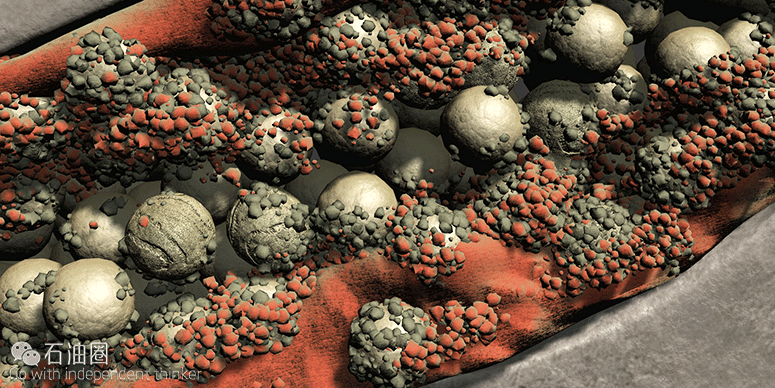Free water-based fluids. Free more production and recovery.
RPM relative permeability modification technology is engineered to alter the wettability of proppant to neutral, preventing the retention of water-based fluid in the proppant pack. As a result, RPM technology increases the effective fracture length, conductivity and permeability of the pack to hydrocarbons, leading to higher production and increased ultimate recovery.
Avoid trapped fluids and lost production
Most untreated proppant is strongly water wet, which creates capillary effects that can lead to water and water-based fracture fluids becoming trapped in the pore throats of the proppant pack. This results in a decrease in the effective fracture length, conductivity and permeability of the fracture. Together with multiphase that can result in increased pressure drop across the fracture, leading to reduced production and estimated ultimate recovery (EUR).
Increased flow, production and recovery
The CARBO portfolio of high quality proppant already provides our clients with more space to flow?, maintaining the highest levels of conductivity in downhole conditions for the life of the well. Now, with the introduction of RPM? neutral wettability relative permeability modification technology, CARBO can help you to further enhance the space to flow.
By preventing water and water-based fracture fluids from becoming trapped, RPM technology increases the effective length and conductivity of your fractures, improves permeability and reduces the pressure drop related to multiphase flow effects. Taken together, these proppantdelivered flow enhancements lead to higher production and recovery.
Neutral wettability.Virtually zero capillary forces.
Altering the proppant pack surface to neutral wettability virtually eliminates capillary forces that prevent water and water-based fracturing fluids from becoming trapped, avoiding a reduction in hydrocarbon flow.
Remove capillary effects
Most conventional proppant is strongly water wet, exhibiting a contact angle < 90°. This allows for easy wetting and dispersion of the water-based fracturing fluids in the fracture, causing them to become trapped in the pore throats of the proppant pack.
RPM technology alters the wettability of the proppant surface to neutral. This leads to a contact angle of ~90°, which virtually eliminates capillary forces that prevent water and water-based fracture fluids from becoming trapped after fracturing and during production. This leads to an increased hydrocarbon permeability.
Enhance the performance of any CARBO ceramic proppant
RPM technology is a surface modification coating applied during the manufacturing process and is available with any CARBO ceramic proppant. Treated proppant is compatible with most fracturing fluids and the coating is stable up to 400°F (205°C) so they can be used in most stimulated wells.
Enhanced flow.Increased production and recovery.
Increased fracture conductivity and permeability, combined with a reduction in pressure drop related to multiphase flow effects increases your production and ultimate recovery.
Increase fracture fluid clean-up, fracture length and conductivity
Proppant enhanced with RPM technology improves fracture fluid clean-up by reducing the retention of water-based fracture fluid, which increases conductivity. The improved fracture clean-up and the reduction in conductivity impairment due to gel damage lead to an increased effective fracture length.
Reduce multiphase flow pressure drop
Multiphase pressure drop effects in the fracture can reduce production and ultimate recovery by favoring one hydrocarbon or fluid phase over another.
When two phases are present in the proppant pack, they compete for the same space to flow. By reducing capillary pressures through neutral wettability proppant, we can significantly reduce the amount of water competing for this space, ultimately allowing more oil production.
Field-proven to significantly increase production
Fractures built with proppant enhanced with RPM technology have been proven in field trials to deliver a significant increase in both oil and gas production, with a rapid payback on the investment in RPM technology.
Features
1.Surface modification that alters the wettability of treated proppant to neutral with a contact angle ~90°;
2.Coating stable up to 400°F (205°C) so suitable for most wells;
3.Treated proppant compatible with most fracturing fluids;
4.Available as a flow enhancement to any CARBO ceramic proppant.
Benefits
1.Increases oil and gas production;
2.Improves water-based fracture fluid clean-up after stimulation;
3.Prevents water-based fluids from becoming trapped in pack pore throats;
4.Increases effective fracture length, conductivity and permeability;
5.Reduces pressure drops due to multiphase flow effects;
6.Virtually eliminates capillary forces in the proppant pack;
7.Increases condensate production to help combat condensate banking.
The well enhanced with RPM technology:
1.Produced an incremental 15%after 1 year;
2.First gas production nearly twice as fast as the untreated well;
3.Delivered a 15% increase in overall production;
4.Experienced an 80% increase in condensate production, indicating the potential effectiveness of RPM technology for combating condensate banking.

 石油圈
石油圈

